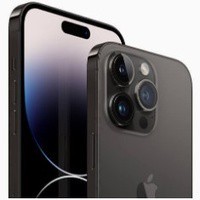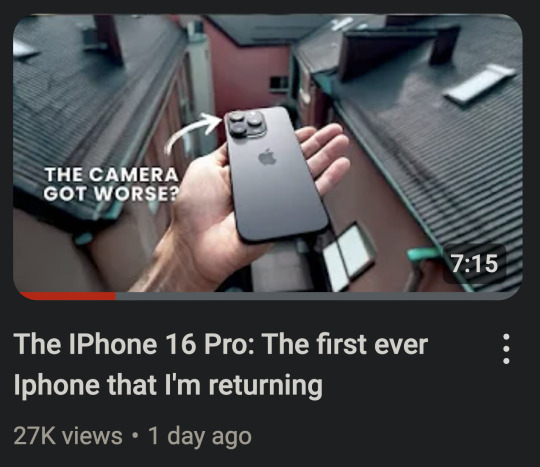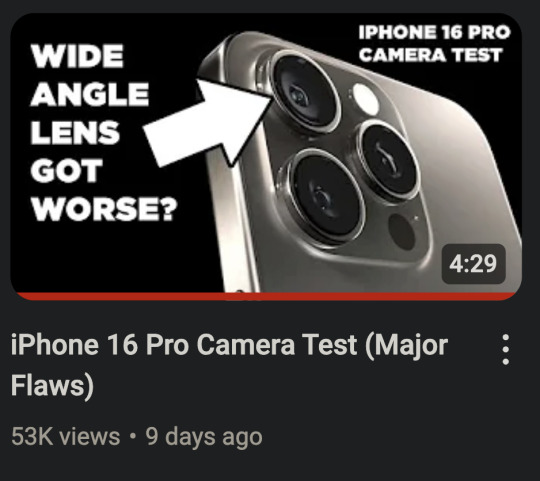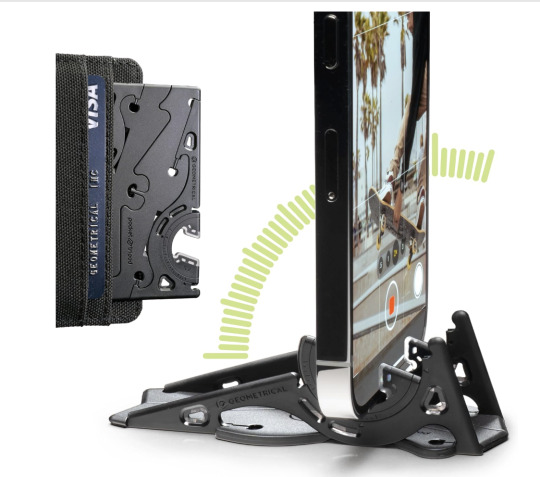#iphone 16 pro review
Explore tagged Tumblr posts
Text
youtube
#iphone16#iphone 16#iphone 16 pro#iphone 16 pro max#iphone 16 plus#iphone#apple iphone 16#iphone 16 review#new iphone#iphone 16 event#iphone 16 news#iphone 16 pro max review#iphone 16 pro review#apple iphone#iphone 16 pro hands on#iphone 16 colors#iphone 16 pro max hands on#iphone 16 battery life#iphone 16 hands on#iphone 16 vs#apple iphone 16 pro#iphone 16 pro max unboxing#new iphone 16#iphone 16 pro max 2024#iphone 16 vs iphone 15#Youtube
1 note
·
View note
Video
youtube
Is the iPhone 16 Pro the Ultimate Upgrade? 5G, 4K Dolby Vision & Game-Ch...
#youtube#iPhone 16 Pro review#iPhone 16 Pro features#Apple iPhone 16 Pro#iPhone 16 Pro camera#iPhone 16 Pro Dolby Vision#iPhone 16 Pro specs#AirPods with iPhone 16 Pro#iPhone 16 vs iPhone 16 Pro comparison#iPhone 16 Pro hands-on review#iPhone 16 Pro vs Samsung Galaxy S24
0 notes
Text

Have a chance to win a brand new iPhone 14
#iphone 14#iphone 14 pro#iphone 14 pro max#iphone 14 plus#iphone#iphone 14 camera#iphone 14 unboxing#iphone 14 vs#apple iphone 14#iphone 13#iphone 14 vs iphone 14 plus#iphone 14 tips#iphone 14 review#starlight iphone 14#iphone 14 vs iphone 13#iphone 14 camera test#iphone 14 plus review#iphone 13 vs iphone 14#iphone 14 camera review#iphone 14 plus vs iphone 14#iphone 14 pro max unboxing#new iphone#iphone 14 unboxing aesthetic#iphone 15#iphone 15 pro#iphone 15 pro max#apple iphone#iphone 11#iphone 16#phone
2 notes
·
View notes
Text
Exciting New Review Video: Apple iPhone 16 & 16 Pro Max!

View On WordPress
#AI#Apple Event#apple intelligence#apple phone#apple phones#apple products#apple review#ARTIFICIAL INTELLIGENCE#best phone in 2024#best phone in 2025#Blog#channel#Code Burner#costly#Gadgets#iPhone#iPhone 16 Pro#iPhone 16 Pro Max#Knowledge#latest#latest gadgets#latest phone#Mobile Phones#news#popular#powerful#richest#russia#shorts#shortsfeed
0 notes
Text
That Apple Reveal Was Like...
So let’s attempt to get through some of the most massive improvements on Apple products that were announced just yesterday. Every phone they put out is the best phone they’ve ever put out… which is true (by default) and here are the best and the worst of it… Your new iPhone can tell you when you’re ovulating, so you know when to get jiggy if you want a kid… or don’t. PLUS, the European Union…
0 notes
Text
youtube
5 Biggest Changes Rumored for iPhone 16 Pro Max If you've been waiting up for an iPhone 16 Pro Max, here are five major updates that are rumored to be come to the largest iPhone Apple has ever made. This iPhone 16 series is expected to launch in the fall, possibly around mid-September.
#iphone 16#iphone 16 pro#iphone 16 leaks#iphone 16 pro max#iphone 16 ultra#iphone 16 rumors#iphone 16 review#iphone 16 camera#iphone 16 design#iphone 16 pro max 2024#iphone 16 news#iphone 16 price#iphone 16 launch#iphone#iphone 16 colors#iphone 16 release date and price#iphone 16 launch date#iphone 16 battery life#iphone 2024#iphone 15#iphone 15 pro max#apple iphone 16#iphone 16 pro leaks#iphone 16 plus#iphone 15 2023#iphone 16 trailer#m tech#Youtube
0 notes
Link
#iphone 16#iphone#iphone 16 pro#design#smartphone#apple#apple iphone#tech#technology#technews#rumors#tech review#latestnews
0 notes
Text
Smartphone cameras are NOT getting worse. (See below for phone photography tips)
I've now seen 3 pro photographers reviewing the iPhone 16 and complaining the cameras are "worse" and blaming Apple for not including revolutionary new camera technology.



And I suppose this is partly Apple's fault. Their marketing and hype machine always goes overboard. But also, that's just how marketing works. Samsung has a "200 megapixel" sensor and Sony has a "Zeiss" lens. And I think it is unrealistic to expect smartphone companies to say "This product has entered the iterative phase and each new model will only be marginally improved over the last one."
Smartphones (from any brand) have become an appliance. You don't buy a new model of microwave every year. And you don't expect every new model of microwave to have new revolutionary technology. And that is pretty much the expectation you should have with most computer hardware from here on out.
And in some ways, that is a good thing. That means the design of the phone has pretty much been perfected and it will last you a long time if you take care of it. You will not be left behind and your phone will be able to handle any new software for most of its lifespan.
So, is Apple getting lazy or is there a reason their hardware is stagnating?
It seems that neither money nor marketing can change the laws of physics.
They cannot make transistors much smaller. Phones and computers are about as fast as current hardware designs can make them (unless there is a shocking scientific breakthrough). From here on out, heavy compute tasks that are beyond your phone or computer will be done in the cloud on giant computer clusters. Thankfully computers and phones seem to be plenty fast for the majority of tasks we ask of them.
I remember Katrina telling me her new computer didn't seem any faster. And I explained the computing tasks she does regularly were not really affected by the increased power and speed of her new computer. If something took 0.1 seconds before and now it takes 0.05 seconds, that is twice as fast. An increase in speed that looks fantastic in advertisements. But it is hard for our brains to perceive. She just didn't do anything on her computer that took it long enough for her to notice. But having a faster and more powerful computer/phone will increase its lifespan and resale value, so it is still prudent to get the best things you can afford at time of purchase.
And I'm afraid smartphone cameras are hitting their own hardware limitations. They can't make the sensors much larger to get better depth of field and low light performance. And cramming in more megapixels doesn't actually add much more detail, if any.
It's physics.
Again.
You cannot get any more performance out of a small plastic lens. Why do you think pro photographers haul around 10 pound lenses still?

There is a formula for detail that never seems to be explained in any camera marketing.
Here is the simplified version...
Detail = Sensor x Lens
Let's say 1 is perfection. You have a sensor that performs at 0.5 and a lens that performs at 0.2.
The total detail will be 0.1.
But in the new model you increase the performance of the sensor to 0.8. WOW! That's so close to 1!
The total detail will be... 0.16.
Now let's imagine we've discovered a magic, physics-defying tiny plastic lens that performs at 0.8 as well.
The total detail jumps to 0.64!
But we all get sucked into a wormhole because we violated the laws of the universe.
Even if you were to design a near perfect (perfect is impossible) sensor that scores 0.99.
Without that magic plastic lens... 0.198
This is why I put Samsung's "200 megapixel" sensors in quotes. Because when paired with the same tiny plastic lens, there isn't much improvement. And that's why a 12 megapixel DSLR from 10 years ago with a giant honking lens can still capture more detail.
Most of the quality from smartphone cameras comes from the computational software processing. Phones actually take many photos at once and combine them to get you a decent image.

While that is still improving a little bit each generation, those improvements are stagnating as well. Until image processing can do a better job of inventing more detail realistically, smartphones are going to have to obey the laws of physics.
So... why are photographers saying the iPhone cameras are worse?
First, the ultra wide angle lens looks softer in low light.
And if you zoom between 1x and 5x, the images look less detailed.
But neither of those things make the cameras *worse*. In fact, the cameras are better for the most part. It's just that Apple decided to compromise on one aspect to improve another. Probably due to market research telling them most people prioritize certain things over others when taking photos.
They increased the resolution of the ultra wide angle sensor to match the detail of the main sensor, but that seems to have lowered the low light performance of the ultra wide. So in good light, you will see an improvement in sharpness. But they could not increase the sensor size to compensate and smaller pixels can have trouble with dim conditions. They probably discovered that people mostly use that lens in good light and they would appreciate the bump in detail more.
But pro photographers often photograph in more challenging lighting conditions because you can capture a more artistic shot. I don't think I could have gotten this shot on a smartphone.

But photo normies are just taking pics of their kids doing weird kid shit.

They aren't really trying to push the limits of their ultra wide angle lenses.
And they increased the zoom of the telephoto lens to 5x from 3x because most people never used the 3x. So images at 5x look great now, but unfortunately if you use anything between 1x and 5x, your image will be *digitally* zoomed. Which is never as good as optical zoom. They basically crop the photo, zoom in, and add sharpening.
So they prioritized people having longer reach and more zoom at the expense of that middle zoom range. Every camera system makes tradeoffs and compromises.
And I hate that I always feel like I am defending Apple, because they do have misleading and dishonest marketing regarding a lot of aspects of their tech. But hating on Apple gets more clicks so content creators also make misleading and dishonest claims.
And so we are just surrounded in a circle of hyperbole from all sides.
Now, if you know these limitations, you can change your approach to photographing stuff to keep them from being an issue. You can reap the benefits without dealing with the new compromises.
Here are some tips to help owners of the new iPhone, but also everyone else too.
Smartphone Photography Tips
Whenever possible, try to use the main 1x camera at only 1x zoom. This has the largest sensor with the most detail and works best in the lowest light. Only use the ultra wide or telephoto if you cannot get the photo otherwise. If you aren't sure you have enough light for ultra wide, take the photo, and then as a safety, take two photos with the main camera side by side and stitch them later with a pano app.
"Zoom with your feet" and don't use "in-between" zooms. Let's say your lenses do 0.5x, 1x, and 5x zoom. Even though you have the option to use other zooms, like 2x or 3x, that is going to compromise your picture quality. It is essentially going to crop your photo and enlarge it, which causes a loss of detail. If fact, if you use 4.5x instead of 5x, your picture will probably look like trash. You are always going to get better results if you can move closer or step back so that you are using the native focal length of your chosen lens. For example, let's say you are taking a photo and you judge the best framing to be at 4x. But you still have 10 feet of space behind you. If you back up and then zoom in to 5x, the phone will switch to that lens and you will get a much clearer picture.
Rule of thumb...
1 to 3x... try to move closer.
4 to 5x... try to move back.
If you hit a wall and end up at 4.5x, you might see if you have a panorama mode and try that instead. Switch to your 5x and do the pano. Or you can take two photos and then stitch them together with software later on. (Stitching panos with an app later will give better quality than pano mode, especially in low light.)
Low light needs stability. Get some sort of stabilizing device for low light photos. Either a phone case that lets you stand up the phone on its own or a mini tripod.
This thing folds to the size of a credit card.

Your phone will detect when it is stable and not being handheld. It will then automatically extend its shutter speed allowing it to drink in more light and give you a better picture.
Tripods are photography magic and will improve your low light photos quite a bit. Motion blur of moving subjects can still be an issue, but photos of a cityscape or landscape will look great.
For selfies, shoot a little bit wide and then crop in. This goes a little contrary to my earlier advice saying cropping lowers detail, but this is specifically for shooting a face. The 0.5x and 1x lenses on smartphone cameras are fairly wide angle. This can cause unflattering proportions with human faces. Wide angle lenses exaggerate distance. Near things look very near and far things look very far. To a wide angle lens, the tip of your nose looks like it is super close but your ears seem like they are a mile away. And that's why you may look a bit "alien" in your selfies.
People's natural instinct is to "fill the frame" with a face. The outer edges of a wide angle lens are more distorted than the very center. So try to keep faces away from the edges of the frame.
And one other trick you can do for selfies and pictures of faces is step back a few feet. Sometimes this is hard, especially with selfies, as your arm is only so long... but if you can take your face photos from just a little bit farther back, you will almost entirely eliminate unflattering distortion. In some cases, just stretching out your arm as far as it will go is enough.
Then you just crop the image with the framing you originally wanted, and your facial proportions will look great.
An example...

Here the distortion is bad because I am not in the center and the lens is too close to my face. The lens thinks my nose is really close and my ears are in Canada.

But when the lens is farther back the edge distortion is less prevalent and my nose and ears (relative to the lens) seem roughly the same distance away. So my proportions look great, but I don't quite have the framing I want.
But with a little cropping...


For social media there is still plenty of resolution to crop in. Cropping isn't bad, it's just always better to use it as a last resort or in a special circumstance like this. I get roughly the same framing as in my wide angle shot, but I don't look like I'm behind a door's peephole trying to sell you the Good News.
I wish they made a "mini" selfie stick that only extended a foot or so. With the main camera that is usually all people need to undo any wide angle issues. I have one of those mini tripods and that works well, but there is no activation button so I have to do a timer. Mirrors work great to help you get some selfie distance.
In any case, all cameras have limitations and compromises. Clickbait titles saying something is WORSE THAN THE OLD ONE are frustrating and wrong.
And people upgrading phones every year are silly. All current name brand smartphones have promised at least 5 years of software updates. I think Google and Samsung are offering 7 years on some models. And Apple has always just let you use your phone until it literally will not work with new software. Which has worked out to 8 years in some cases (with a battery swap).
Phones are now appliances. For now, hardware will improve 10 to 15% from generation to generation until physics breaks. So if you want a 50% improvement, wait 5 years and you'll think your new phone is awesome. If you upgrade every year, it is going to be difficult to see the change.
I hope to be starting a little course on smartphone photography in the near future. All modern phones are capable of taking amazing pictures. And as long as you understand their limitations you can mitigate or avoid them. And that is what I plan to teach.
684 notes
·
View notes
Text
youtube
Best Secret iOS 16 Features: Tricks to Make Your iPhone Life Easier
In this video, we'll be showcasing some of the best and most exciting secret features of iOS 16. With these tricks, you'll be able to make your iPhone experience a whole lot easier. From hidden gestures to new productivity tools, we've got it all covered. So, sit back, relax, and get ready to learn some of the most innovative and handy tips for your iPhone
#ios 16#ios 16 features#ios 16 customization#ios 16 update#ios 16 review#ios 16.3#ios 16 top features#ios 16 hidden features#ios 16 tips and tricks#ios 16 setup#ios 16.3 update#ios 16 best features list#ios 16 unsend message#iphone 15#iphone 15 pro#iphone 15 ultra#iphone#iphone 15 pro max#iphone tips and tricks#iphone hidden features#best iphone features#new iphone#ios 16 new features#ios 16 widgets#ios 16 tips#iphone tips#ios 16 release#Youtube
1 note
·
View note
Text
iPhone 16 Pro Camera Review | NEW Camera Control Button
youtube
2 notes
·
View notes
Note
https://www.tumblr.com/starsinthesky5/761545309718544384/im-getting-a-new-phone-within-the-next-month-or
omg queen what phone are you getting😛😛 i always find phone hauls/reviews so interesting AND IDK WHY LMAO.
but no girl i feel you. i got an iphone 11 in the 9th grade for my birthday and that bitch was my BABY. like i didn’t get a new phone until january of this year and the only reason i did is because she just stopped charging one day. may she rest in peace
but after i got over it, i realized how easier my life was after not having to worry if my phone was gonna explode because i was scrolling on instagram while on the phone with someone🥰
omg me too. i think im aiming for the iphone 16 pro in the desert titanium color (also the pro lineup colors are giving TTPD cover art variant colors)
i love my 13 but she’s dying. it’s a space heater, the camera quality feels like it got worse, and my battery life is in the sewer. it’s time to say bye. i also need more storage. 256 isn’t cutting it I guess 😍
ill give a real review whenever i get it 😍
2 notes
·
View notes
Link
PITAKA iPhone 16 Pro Max Tactile Woven Case #REVIEW Lightweight bumper-style woven case with Aramid Textile Flourish #iphone16promax @PitakaGallery https://macsources.com/pitaka-iphone-16-pro-max-tactile-woven-case-review/
0 notes
Text
Cât costă cu adevărat producția unui iPhone 16 Pro și Pixel 9 Pro
Sursa foto: JSL Review | YouTube În timp ce consumatorii scot din buzunar peste 1.000 de euro pentru cele mai noi smartphone-uri premium, o analiză recentă dezvăluie adevăratele costuri de producție ale smartphone-urilor Google Pixel 9 Pro și iPhone 16 Pro. Diferențele aruncă o lumină nouă asupra marjelor de profit ale celor doi giganți. Diferență semnificativă între Google și Apple Conform…

View On WordPress
0 notes
Text

Have a chance to win a brand new iPhone 14
#iphone 14#iphone 14 pro#iphone 14 pro max#iphone 14 plus#iphone#iphone 14 camera#iphone 14 unboxing#iphone 14 vs#apple iphone 14#iphone 13#iphone 14 vs iphone 14 plus#iphone 14 tips#iphone 14 review#starlight iphone 14#iphone 14 vs iphone 13#iphone 14 camera test#iphone 14 plus review#iphone 13 vs iphone 14#iphone 14 camera review#iphone 14 plus vs iphone 14#iphone 14 pro max unboxing#new iphone#iphone 14 unboxing aesthetic#iphone 15#iphone 15 pro#iphone 15 pro max#apple iphone#iphone 11#iphone 16#phone
0 notes
Text
iPhone 16 Pro and iPhone 16 Pro Max Review and Comparison: A Whole New Level When we talk about Apple, especially when it comes to their Pro lineup, expectations are already sky-high. But with the iPhone 16 Pro and iPhone 16 Pro Max, Apple’s pushing things up a notch—or maybe even ten notches? Let’s dive into this, no fuss, just straight to the meat. Introduction: iPhone 16 Pro and iPhone 16 Pro Max – The Next Big Thing? The iPhone 16 Pro and iPhone 16 Pro Max are the latest heavy hitters from Apple, packed with new features, upgraded performance, and jaw-dropping cameras. These aren’t just phones—they're tiny computers in your pocket that can pretty much do anything. From creating pro-level content to handling multiple tasks seamlessly, the new iPhones are designed to fit into every aspect of your daily life. Now, why did I decide to try them out? Simple. I wanted to see if all the hype around these devices was worth it. Was the camera as good as everyone says? Could the battery last a whole day of non-stop use? Most importantly, I was hoping to find out if upgrading to the iPhone 16 Pro or iPhone 16 Pro Max would make a difference in my everyday workflow and entertainment consumption. It wasn’t just about the bells and whistles—I wanted to know if these phones could truly enhance how I use tech daily. First Impressions: Sleek, But Are We Surprised? So, you’ve got your hands on the iPhone 16 Pro or the iPhone 16 Pro Max. The first thing? It’s slick. Apple nails it on design every single time. The edge-to-edge display, slightly tweaked (but let’s be real, it’s not THAT different from the iPhone 15 Pro), is what makes it feel premium. You know that feeling when you unbox something and everything feels just right? That’s exactly what you get here. But don't expect a revolutionary change. It's like when you get a fresh pair of kicks — not a complete game changer, but it looks and feels sharper. Features of the iPhone 16 Pro and iPhone 16 Pro Max When we talk about the iPhone 16 Pro and iPhone 16 Pro Max, it’s not just about the shiny new look; it’s the features packed inside that make these devices stand out. Here’s a breakdown of the main features and how they work in real-world use: A18 Bionic Chip – Lightning-Fast Performance The A18 Bionic is Apple’s newest chip, and it’s a beast. This processor takes care of everything, from handling intense gaming sessions to making multitasking smoother than ever. It’s designed to boost AI and machine learning tasks, meaning things like photo editing or video rendering are faster. If you’re someone who jumps between apps constantly or does heavy work like video production on your phone, this chip is a lifesaver. Effectiveness: This feature is incredibly effective. The performance upgrade feels noticeable, especially when running demanding apps. 48MP Camera System – Ready for Pro Shoots Both the iPhone 16 Pro and iPhone 16 Pro Max come with a 48MP main camera, enhanced by Apple’s software. The camera is built for low-light environments and offers sharper, clearer photos. Night mode is much improved, and portraits look almost studio-level without even trying too hard. On the Max, you get even more stability and higher quality in low-light settings, making it perfect for photography buffs. Effectiveness: For content creators, this is a game-changer. It’s almost like carrying a DSLR in your pocket. Whether you’re snapping pics for social media or capturing professional content, the clarity and detail are stunning. Display: Max-ing Out This is where the iPhone 16 Pro Max pulls ahead. That bigger, brighter display is a dream for content junkies. If you're the type that spends hours spree-watching or endlessly scrolling TikTok, this screen will spoil you. While the iPhone 16 Pro has a solid display, the Max’s size makes a difference. It’s not just about bigger pixels – it’s about having more real estate to work with. Text looks crisp. Videos? Super smooth.
But is it worth the upgrade? Depends on your daily habits. If you’re always on your phone, maybe. But if you just want the occasional Netflix session on your commute, the regular Pro will do you just fine. 120Hz ProMotion Display – Smooth and Fluid The iPhone 16 Pro and Max both feature a 120Hz ProMotion Display, which makes everything from scrolling to gaming feel smoother and more responsive. This feature is especially noticeable in gaming and when switching between apps. If you’re into mobile gaming or watching videos, you’ll love the silky transitions. Effectiveness: It’s a subtle yet powerful addition. Once you get used to the fluidity, going back to a regular 60Hz display feels like a downgrade. Battery Life – Power to Last All Day The iPhone 16 Pro Max has a larger battery compared to the iPhone 16 Pro, and you’ll feel it during the day. With normal use, the Pro can last a solid day, but the Max is a step up, pushing through heavy use without begging for a charger until late into the night. It’s perfect for power users. Effectiveness: The battery life on both models is impressive, but the Max truly shines here. It’s effective for people who rely on their phones for long hours without needing to constantly recharge. Customizable Lock Screens and Widgets – Make It Yours One cool addition is how customizable the lock screens and home widgets have become. You can now have different widgets for everything from weather updates to your favorite apps, displayed directly on your lock screen. This feature allows users to personalize their iPhones to match their lifestyles and habits. Effectiveness: It’s a neat feature, especially for productivity. You can have quick access to everything you need without even unlocking your phone, which streamlines your workflow. Face ID with Under-Display Sensor – Unlock with Ease Apple’s Face ID technology gets an upgrade with the sensor now tucked under the display. This means no more notchs and the unlocking speed is faster than ever. It’s more secure and smooth, letting you get into your phone instantly. Effectiveness: The under-display sensor works flawlessly, and you won’t even notice it’s there. The seamless experience adds to the premium feel of the device. MagSafe and Wireless Charging – Hassle-Free Power Apple’s MagSafe system is back, allowing for snap-on accessories like wallets and chargers. Wireless charging is also faster than before, and with MagSafe, aligning the charger is super easy. You can throw your phone on the charger without thinking twice. Effectiveness: It’s one of those features you don’t realize you love until you have it. No more fiddling with cables—just snap and charge. It’s effective for people who want a clean, easy charging experience. Conclusion on Features Each feature of the iPhone 16 Pro and iPhone 16 Pro Max is designed to enhance how you use your phone daily, from performance to personalization. Whether you’re into photography, gaming, or just want something that works efficiently without hassle, these phones pack the tools to make it happen. The iPhone 16 Pro Max might have the edge in terms of battery and display, but both models deliver features that will have you wondering how you ever lived without them. Performance: Fast is an Understatement I mean, did you expect Apple to put out a slow phone? That new A18 chip? It’s ridiculous. Multitasking on the iPhone 16 Pro is buttery smooth. The Max? Just gives you more room to play around with those apps. Gaming? No problem. Video editing on the go? Done in seconds. But honestly, when’s the last time you thought, “Wow, my iPhone is slow”? Exactly. It’s just getting faster, and at this point, it's more about flexing tech muscle than fixing any real problem we users have. Which One's for You? So, iPhone 16 Pro or iPhone 16 Pro Max? Here’s the deal: If you like compact, easy-to-hold phones that don’t sacrifice power, the iPhone 16 Pro is your buddy. It’s a powerhouse that fits in your pocket.
But if you’re someone who craves that big-screen experience and doesn't mind the extra bulk, the Max is where it’s at. Whether it's gaming, Netflix satiating, or doing serious work on the go, the Max feels more immersive. FeatureiPhone 16 ProiPhone 16 Pro MaxDisplay Size6.3 inches6.9 inchesResolution2556 x 1179 pixels2796 x 1290 pixelsChipsetA18 BionicA18 BionicMain Camera48MP + 12MP + 12MP (Triple)48MP + 12MP + 12MP (Triple)Front Camera12MP TrueDepth12MP TrueDepthBattery LifeUp to 22 hoursUp to 28 hoursChargingMagSafe, 20W fast chargingMagSafe, 20W fast chargingOperating SystemiOS 18iOS 18RAM8GB8GBStorage Options128GB, 256GB, 512GB, 1TB128GB, 256GB, 512GB, 1TBWeight195 grams225 gramsFace IDYes, under-displayYes, under-displayWater ResistanceIP68 (up to 6 meters for 30 mins)IP68 (up to 6 meters for 30 mins)5G SupportYesYesColors AvailableGraphite, Silver, Gold, Sierra BlueGraphite, Silver, Gold, Sierra Blue iPhone 16 Pro and iPhone 16 Pro Max vs Competitors: How Do They Stack Up? The iPhone 16 Pro and iPhone 16 Pro Max are undoubtedly flagship phones, but they're not without competition. To see where they truly stand, let’s compare them with some of their biggest rivals in the market: the Samsung Galaxy S24 Ultra, the Google Pixel 9 Pro, and the OnePlus 12 Pro. Design & Build Quality iPhone 16 Pro / Pro Max: Sleek, premium, and classic Apple design. With stainless steel frames and a ceramic shield, the iPhones continue to lead in durability and design aesthetics. Samsung Galaxy S24 Ultra: Sleek and futuristic, with its curved display and ultra-thin bezels. It’s heavier and bigger than the iPhone 16 Pro, and more similar in size to the Max. Google Pixel 9 Pro: Focuses on simplicity, with a slightly less premium feel but a very ergonomic design. Pixel goes for practicality over flashy design. OnePlus 12 Pro: Known for its clean and minimalist design, similar to the iPhone in terms of simplicity. However, it doesn’t feel as robust as the iPhones in hand. Verdict: If you want something more compact but still premium, the iPhone 16 Pro is your best bet. For bigger screens, the S24 Ultra and iPhone 16 Pro Max are your go-tos. Display iPhone 16 Pro / Pro Max: 6.1-inch and 6.7-inch Super Retina XDR displays, both with 120Hz ProMotion technology. The colors are vivid, and the brightness hits up to 2000 nits for outdoor viewing. Samsung Galaxy S24 Ultra: Features a 6.8-inch Dynamic AMOLED 2X display, with a 120Hz refresh rate and even more vibrant colors than the iPhones. It’s widely regarded as having one of the best displays. Google Pixel 9 Pro: 6.7-inch OLED screen with a 120Hz refresh rate. Google’s focus on accurate colors and natural tones makes this display a delight, but it lacks the extreme brightness of the iPhone and Samsung models. OnePlus 12 Pro: 6.7-inch Fluid AMOLED display with 120Hz. It’s excellent for gaming and media, but not quite on par with the iPhones or Samsung’s offerings in terms of peak brightness. Verdict: If brightness and sharpness matter the most, the iPhone 16 Pro Max and Samsung Galaxy S24 Ultra take the crown, though Samsung’s display may have the slightest edge. Camera iPhone 16 Pro / Pro Max: 48MP triple-camera system with ProRAW and Night Mode. The Max model edges out slightly in terms of low-light performance. Apple’s computational photography is best for consistent, true-to-life images. Samsung Galaxy S24 Ultra: 200MP main camera with amazing zoom capabilities (up to 100x). Samsung’s cameras excel in versatility and offer more zoom options than the iPhone, but can sometimes oversaturate colors. Google Pixel 9 Pro: 50MP primary camera with AI-powered computational photography. Google's AI-enhanced software continues to be the best for point-and-shoot simplicity, though it lacks the depth of features you get with Apple and Samsung. OnePlus 12 Pro: 50MP triple-camera setup. It’s a solid shooter but doesn't quite match the image quality and versatility of its competitors, particularly in low-light scenarios.
Verdict: If zoom and versatility are important, Samsung Galaxy S24 Ultra wins hands down. But for most users, the iPhone 16 Pro / Pro Max offers a more balanced camera system, especially with its seamless software integration. Performance iPhone 16 Pro / Pro Max: Powered by the A18 Bionic chip, which is blazing fast, handling gaming, multitasking, and AI tasks effortlessly. Apple’s software and hardware integration ensures smooth performance across the board. Samsung Galaxy S24 Ultra: Uses the Snapdragon 8 Gen 3 processor. It’s extremely powerful, but benchmark tests show Apple’s A18 chip is still ahead in terms of raw speed and efficiency. Google Pixel 9 Pro: Powered by the Google Tensor G3 chip, which focuses more on AI-driven tasks than raw performance. It’s good for day-to-day tasks but lags behind the iPhone in gaming and high-performance tasks. OnePlus 12 Pro: Also runs on the Snapdragon 8 Gen 3, providing top-notch speed and performance. It’s comparable to the Samsung S24 Ultra, but like most Android devices, it can feel a little less optimized compared to the iPhone. Verdict: The iPhone 16 Pro / Pro Max takes the crown for sheer performance, especially if you're looking for the best mix of speed and efficiency. However, all the phones perform admirably. Battery Life iPhone 16 Pro / Pro Max: Offers up to 22 hours on the Pro and 28 hours on the Max. Apple’s battery efficiency is commendable, especially with its A18 chip optimizing energy use. Samsung Galaxy S24 Ultra: Known for having a slightly larger battery, but the higher resolution display and power-hungry features mean its battery life is comparable to the iPhone 16 Pro Max in real-world use. Google Pixel 9 Pro: Battery life is decent, lasting about a day of moderate use, but it’s not as efficient as the iPhones, especially when running intensive tasks. OnePlus 12 Pro: Battery life is strong, but like the Galaxy S24 Ultra, heavy use can drain it quicker than the iPhone. Verdict: For sheer longevity, the iPhone 16 Pro Max is a top choice, but the Samsung Galaxy S24 Ultra isn’t far behind. Software & Ecosystem iPhone 16 Pro / Pro Max: Runs iOS 18, with a focus on privacy, seamless integration with other Apple devices (Mac, iPad, Apple Watch), and regular updates. Samsung Galaxy S24 Ultra: Runs One UI on Android 14. It’s highly customizable and integrates well with Samsung’s ecosystem, but it lacks the smooth continuity across devices that Apple offers. Google Pixel 9 Pro: Offers a clean, stock Android 14 experience with exclusive Google features. If you're heavily invested in Google’s services, this phone makes everything simpler. OnePlus 12 Pro: Runs OxygenOS over Android, which is fast and clean, but doesn't offer the same ecosystem connectivity as Apple or even Samsung. Verdict: If you’re tied into the Apple ecosystem, the iPhone 16 Pro / Pro Max offers unbeatable integration. Google offers simplicity, while Samsung provides customization. Overall Comparison Conclusion Each phone has its strengths: The iPhone 16 Pro and Pro Max excel in performance, user experience, and a balanced camera system. Samsung Galaxy S24 Ultra is for those who want a larger, more vibrant display and cutting-edge camera zoom. Google Pixel 9 Pro is perfect for pure simplicity and AI-driven photography. OnePlus 12 Pro is a solid performer but doesn’t quite reach the heights of the others in certain areas like the camera. In terms of a complete package, the iPhone 16 Pro or Pro Max offers the best balance of performance, ecosystem integration, and reliability. However, if display and zoom capabilities are your priority, the Samsung Galaxy S24 Ultra could be the better option. Final Thoughts At the end of the day, whether you go for the iPhone 16 Pro or the iPhone 16 Pro Max, you're getting top-tier performance. Apple knows what they're doing, and they do it well. But hey, we’ve come to expect that, right?
The differences between these two are more about personal preferences than anything else. If you're thinking of upgrading, ask yourself: do you want something big and bold, or sleek and powerful? Either way, Apple’s got you covered. Pros and Cons of the iPhone 16 Pro and iPhone 16 Pro Max iPhone 16 Pro iPhone 16 Pro Max
0 notes
Text
iPhone 16 Pro review: Apple's most advanced smartphone now has a larger display and its fastest processor to date
New Post has been published on Sa7ab News
iPhone 16 Pro review: Apple's most advanced smartphone now has a larger display and its fastest processor to date
Built for Apple Intelligence, the iPhone 16 Pro models offer significant upgrades, including a new Camera Control button and longer battery life.
... read more !
0 notes